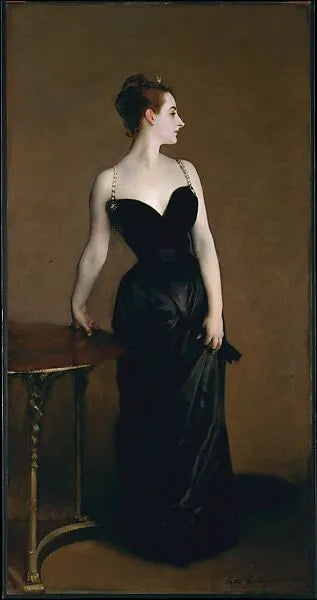Madame X is a famous painting by an American artist named John Singer Sargent. The painting was originally titled Portrait of Mme… when it was exhibited for the first time in the Paris Salon in 1884. Sargent managed to capture the woman’s elegance and sophistication with her long black satin dress with a jeweled strap and a crescent tiara on her head, which symbolizes the goddess Diana. The whiteness of her skin, which is described as an “aristocratic pallor,” is contrasted by the brown background and the black dress she wore. To emphasize on her elegance, the woman in the painting posed as both “present and assertive yet absent at the same time.” However, in the original painting, the woman’s strap was off her shoulder, which is considered too sexual at that time. Despite how beautiful the piece turned out, people were furious and viewed the painting as “sensual and aloof.” Due to its unpopularity, Sargent ended up fleeing the country, and the woman’s reputation amongst her Parisian elites was ruined.
But first of all, who is the woman in the painting and why is it considered so scandalous?
The woman in the painting is Virginie Amelie Avegno who was born in Louisiana to Creole parents. After the death of her father during the Civil War and after taking out too many loans to manage the family’s plantation, Virginie’s mother decided to move to Paris, France, and have her daughter married. Virginie desired to move up the social ladder and be part of the Parisian elites. She was known as “a professional beauty,” as someone who uses their looks to elevate their status in society. She is known for having an hourglass figure, alabaster skin, elegance, and style. American painter Edward Simmons described Virginie as someone he “could not stop stalking… as one does a deer.” Eventually, at the age of 23 years old, Virginie married Pierre Gautreau, a wealthy banker twice her age, and made it to the upper social class.
Sometime around 1882, John Singer Sargent and Madame Gautreau met. Sargent was determined to have a high profile sit for one of his paintings as a way to boost his career. With both Gautreau and Sargent “motivated by a shared desire” to make a name for themselves, Gautreau agreed to sit for Sargent in February 1883. During the process, Gautreau “became disillusioned by the idea of sitting for long periods of time.” Sargent described her as “the unpaintable beauty and hopeless laziness of Madame Gautreau.”
After making multiple sketches, Sargent finally finished the painting. Proud of his work, he showcased his piece at the Paris Salon in 1884 titled as Portrait of Mme… to protect Gautreau’s identity. However, Gautreau’s physical features were so distinguishable that people immediately recognized her. Despite how beautiful the painting turned out, people were furious with it.
For starters, her neckline was considered too low, revealing too much skin. Second, people were concerned about her “ghostly” complexion, suspecting her ingesting arsenic as a way to lighten her skin. Lastly, and what seemed to be the most controversial, the original painting showed one of Gautreau’s jeweled straps falling off her shoulder.
With Gautreau’s mother’s multiple demands, Sargent repainted the strap to tightly fit her shoulder—just as the painting we know today. Unfortunately, despite Sargent’s effort to save Gautreau’s reputation, the damage was done. Certain newspapers, such as The Times, referred to Gautreau as a “loose woman.” Because of her damaged reputation caused by a scandalous portrait, Gautreau’s high-profile circle dissociated itself from her. She remained in France and continued to commission a few more portraits. Virginie Amelie Avegno Gautreau died in 1915 in Cannes, France at the age of 56.

On the other hand, Sargent fled to London after the scandal, where he continued to paint. He eventually had a successful career in Britain and America. In 1916, after Gautreau’s death, Sargent sold the painting to the Metropolitan Museum of Art (the Met). He asked the museum to keep the woman’s identity secret despite it being known already. At the same time, Sargent decided to change the title of the portrait to what we know now as Madame X. “I suppose it’s the best thing I’ve ever done,” Sargent said in regards to his infamous painting. Over time, Madame X is arguably considered to be Sargent’s “most famous masterpiece.”
Despite the painting’s unpopularity during its time, it was later imitated by other artists. Cuban-American fashion designer Luis Estévez designed a black dress inspired by Madame X’s famous satin dress. It was worn and modeled by Dina Merril and was photographed by Milton H. Greene, which was published in Life magazine in January 1960.
Currently, the painting can still be viewed at the Met in Gallery 771. Even after Gautreau’s death, her elegance and style have remained admirable, while Sargent became the painter he wanted to be. I guess we can all agree that both Gautreau and Sargent definitely made a name for themselves.
©ArtRKL™️ LLC 2021-2023. All rights reserved. This material may not be published, broadcast, rewritten or redistributed. ArtRKL™️ and its underscore design indicate trademarks of ArtRKL™️ LLC and its subsidiaries.





